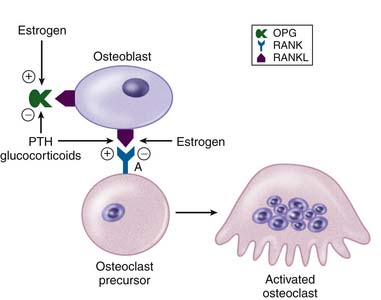12 Osteoporosis and the Aging Spine: Diagnosis and Treatment
KEY POINTS
Osteoporosis is a systemic debilitating disease of the skeleton, characterized by significantly decreased bone mass in combination with the deterioration of bone microarchitecture. This process results in weakened bone with a great propensity for fracture with low-energy stress. As the average life expectancy and median age of the population rises, fractures secondary to underlying osteoporosis are becoming increasingly commonplace. More than 1.5 million osteoporotic fractures occur annually in the United States, the majority of which occur in the spine, hip, and wrist.1 Women are predominantly affected; a recent study estimates that as many as one in two women who are older than 50 years of age will suffer an osteoporotic fracture.2 These fractures can result in marked morbidity and mortality. For example, a single vertebral compression fracture in women is associated with a 1.2-fold increased age-adjusted mortality rate, and the presence of five fractures increases that risk to 2.3-fold.3 In addition, a vertebral fracture increases the risk of a second vertebral fracture by 5-fold, and a hip fracture by 2-fold. Among patients with osteoporotic hip fractures, only 25% of patients ever make a full recovery, while 20% die within the year secondary to complications. Thus, spine surgeons must be increasingly suspicious of this disease in certain patient demographics, achieve a firm understanding of the pathogenesis of osteoporotic bone and the conditions that result in bone fragility, and become familiar with the current strategies for diagnosis, prevention, and treatment of osteoporosis.
Physiology of Bone Remodeling and Bone Turnover
Bone remodeling is a complex process that is regulated both locally and systemically. As previously mentioned, RANKL/RANK interactions at the local level promote induction of osteoclast activity and subsequent remodeling. Conversely, osteoprotegerin (OPG) is a soluble receptor for RANKL that acts as an antagonist to decrease osteoclastic activation and thereby reduce the rate of bone resorption. Interestingly, there are a number of systemic signaling mechanisms that act through the RANKL/RANK/OPG pathway to regulate bone homeostasis.4 For example, parathyroid hormone (PTH) and the glucocorticoids both act to increase local expression of RANKL but decrease concomitant expression of OPG, resulting in a net increase in osteoclast activation and bone resorption. Alternatively, estrogens act to increase the local expression of OPG and decrease RANKL, which results in a net decrease in osteoclast activity and bone resorption (Figure 12-1). Derangement of these pathways can alter the delicate balance between bone resorption and bone formation, and may result in a net decrease of bone formation that contributes to the development of osteoporosis.
Diagnosis of Osteoporosis
Although a good clinical understanding of osteoporosis takes into account the pathophysiology of bone remodeling, mineralization changes, and variable bone quality of the patient, the diagnosis of osteoporosis until recently has relied upon a single criterion: the bone mineral density. The current gold standard of measuring BMD is dual-energy x-ray absorptiometry (DXA), which uses an x-ray beam to calculate the patient’s BMD. The most preferred skeletal sites for evaluation of BMD are the spine and hip, because these two locations provide the best data for correlating low BMD with the risk of future fracture BMD is reported as the T-score, which is a measurement of how many standard deviations the patient’s bone density is below the mean of young, healthy individuals at their peak bone mass. Based on this T-score, the World Health Organization (WHO) developed a classification system to define osteoporosis (Table 12-1).
| T-Score | Diagnosis |
|---|---|
| − 1.0 or above | Normal bone |
| Below −1.0 to above −2.5 | Osteopenia |
| − 2.5 or below | Osteoporosis |
| − 2.5 or below with fracture | Severe osteoporosis |
Secondary osteoporosis is defined by the presence of some preexisting disease process or other causative factor, which causes a secondary decline in BMD (Table 12-2). Forty-five percent of osteoporotic women and 66% of osteoporotic men have their osteoporosis secondary to some underlying condition. Therefore patients with secondary osteoporosis must be identified because definitive treatment of the underlying cause is necessary to prevent further bone loss, and thus lower the risk of fracture. In this regard, it is important to consider the patient’s BMD using the Z-score. The Z-score indicates how many standard deviations the patient’s BMD is below the expected value for his or her own age. The Z-score cannot be used to diagnose osteoporosis, but it is useful for screening the patient for secondary causes. A Z-score of −2.0 or lower should increase the index of suspicion that underlying medical problems, medications, or other factors may be responsible for the patient’s low BMD.6
TABLE 12-2 Causes of Secondary Osteoporosis5
Evaluation for Osteoporosis
Once diagnosed with osteoporosis, a complete medical history should be obtained with particular attention to the risk factors for osteoporosis. These include age of 65 years or older, a history of vertebral fracture or any fracture during childhood, a family history of hip fracture, low body weight (BMI < 21 or weight < 127 lb), cigarette smoking, and use of corticosteroids for more than 3 months.6 The physical examination should be performed particularly at the spine region. Height should be measured and compared with the greatest known height to determine height loss, which is an indicator of the presence of vertebral compression fractures. Balance and walking gait should be observed in each individual. The assessment of functional balance is performed by using the single limb stance test and the 6-minute walking test.
Screening for Osteoporosis with Bone Mineral Density Measurement
A number of risk factors for osteoporosis have been identified by the International Society for Clinical Densitometry (ISCD),7 and should be used to guide the screening process in a cost-effective manner. The current indications for BMD testing include any patient who is one or more of the following:








